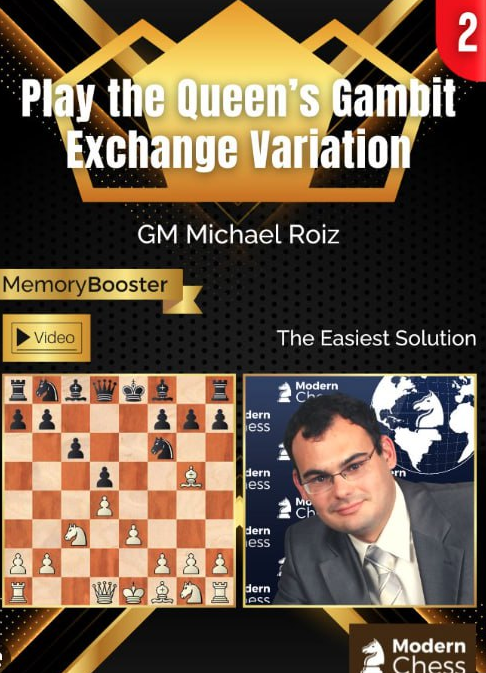$100 Original price was: $100.$4Current price is: $4.
10000 in stock
In this database, GM Michael Roiz completes his repertoire based on 1.d4 d5 2.c4 e6 3.Nc3 Nf6 4.cxd5

While Part 1 was entirely dedicated to the Carlsbad type of position arising after 4…exd5, the current database also deals with the Semi-Tarrasch which occurs after 4…Nxd5. Additionally, in this course, GM Roiz deals also with 4…exd5, thus covering lines that cannot be found in Part 1.
The database consists of 11 theoretical chapters, 11 interactive test positions, a Memory Booster, and Video Version (2.5h Running Time).
Let’s take a brief look at some of the most interesting aspects of the database.
Chapter 1 deals with the position arising after 4…exd5 5.Bg5 Bb4

Black is aiming to play the Ragozin, although the king’s knight is still on g1. This yields White an additional and important possibility of ..Nge2 at once or after Bf1-d3. In his analysis, Roiz shows how exactly White can obtain an edge against this line.
Chapter 2 is dedicated to 5…c6 6.e3 Qb6

This straightforward attempt to unpin the f6-knight is dubious because Black lacks development. The author proves that the simple 7.Qc2 Ne4 8.Bf4 is enough for a stable advantage.
The main subject of Chapter 3 is the line 5…c6 6.e3 Be6

A relatively rare move. The idea is similar to 6…h6 7.Bh4 Be6, and in some cases it can transpose into one of the positions from that Chapter, but there is a difference. First of all, White isn’t obliged to retreat his bishop on g3 in response to …h7-h6 and g7-g5. In this chapter, you will see that the plan with f2-f3 and e3-e4 works pretty well against this setup.
In Chapter 4, Roiz examines a very typical position. The line goes 5…Be7 6.e3 0-0 7.Bd3 h6 8.Bh4 b6

By making this move, Black shows his intention to play with ”hanging pawns”, since …c7-c5 should follow sooner or later. This setup was popular decades ago – in particular, it was tested in a few games from the candidates match Kasparov – Beliavsky. After studying this chapter, you will understand why here is more precise to develop the knight on f3.
Chapter 5 feature another highly important Carlsbad type of position:

This position has been also dealt with in Part 1 of the survey. In the first database, however, GM Roiz focused on 11…Nf8. In this chapter, he deals with all the remaining important moves – 11…Ne4, 11…b5, 11…b6, and 11…a5. These moves are very important for the understanding of the structure. In his analysis, Roiz proves that White can fight for an edge against all these options.
Chapter 6 deals with the following position:

The same approach as in all the systems with Nf6-h5: By exchanging the bishops, Black partly solves his space issues and makes it harder for White to play … e3-e4, as e3 is under the control of Black’s heavy pieces. On the downside, the h5-knight is temporarily out of play.
At this point, Roiz suggests 12.Bxe7 Qxe7 13.a3

The author makes the following comment about this move, “I like this useful waiting move: White can still consider the standard plan with b2-b4 or the expansion in the centre with f2-f3. At the same time, Black will have to decide where he wants to host the queen’s knight.”
Chapters 7 and 8 feature the famous endgame arising after 5…c6 6.e3 Bf5 7.Qf3 Bg6 8.Bxf6 Qxf6 9.Qxf6 gxf6

This endgame has been tested on the highest level. Black hopes that his bishop pair will compensate for the inferior pawn structure. Strategically speaking, however, Black’s concept is a bit risky since White often manages to consolidate his static advantage.
The recommendation of Roiz is 10.Nf3 Nd7 11.Nh4, immediately starting to fight for the f5-square. After 11.Nh4, Black has two main moves – 11…Be7 examined in Chapter 7 and 11…Nb6 which is the subject of Chapter 8.
The final three chapters deal with the highly popular Semi-Tarrasch Defence.
After 4…Nxd5 5.e4 Nxc3 6.bxc3 c5, Roiz suggests 7.Rb1.

This is the second choice by statistics. GM Roiz likes it because it allows White to avoid the immediate exchange of dark-squared bishop. Also, the rook is quite active and makes it harder for the opponent to develop his light-squared bishop.
Chapter 9 is dedicated to 7…cxd4 followed by 8…Nc6, and 9…Bb4+. Even though this is a solid option, Roiz proves that White can rely on a small edge.
The last two chapters are dealing with the position arising after 7…Be7 8.Nf3 0-0 9.h4

This aggressive approach became especially popular after Karjakin’s victory over Kramnik. The advance of the h-pawn puts Black’s king under definite pressure, although it takes 2 tempi.
At this point, Black’s most flexible continuation is 9…b6. This move is extensively analyzed in Chapter 11. All the alternatives are covered in Chapter 10. In his analysis, Roiz demonstrates how White can create a lot of practical problems for Black in the Semi-Tarrasch
Average Star Rating: 5.0 out of 5 (5 vote)
If you finish the payment today, your order will arrive within the estimated delivery time.Only logged in customers who have purchased this product may leave a review.





Tyrel –
The first time I got the urges to leave a comment, but this is simply a top-notch thing you can find.
Trey –
Just love the design and the customer support is the nicest.
Jeff –
Been using a lot of items, this one is obviously the best
Herman –
Great item! It provides too many things compared to its price charged.
Felton –
I like this item and also the customer service of them.